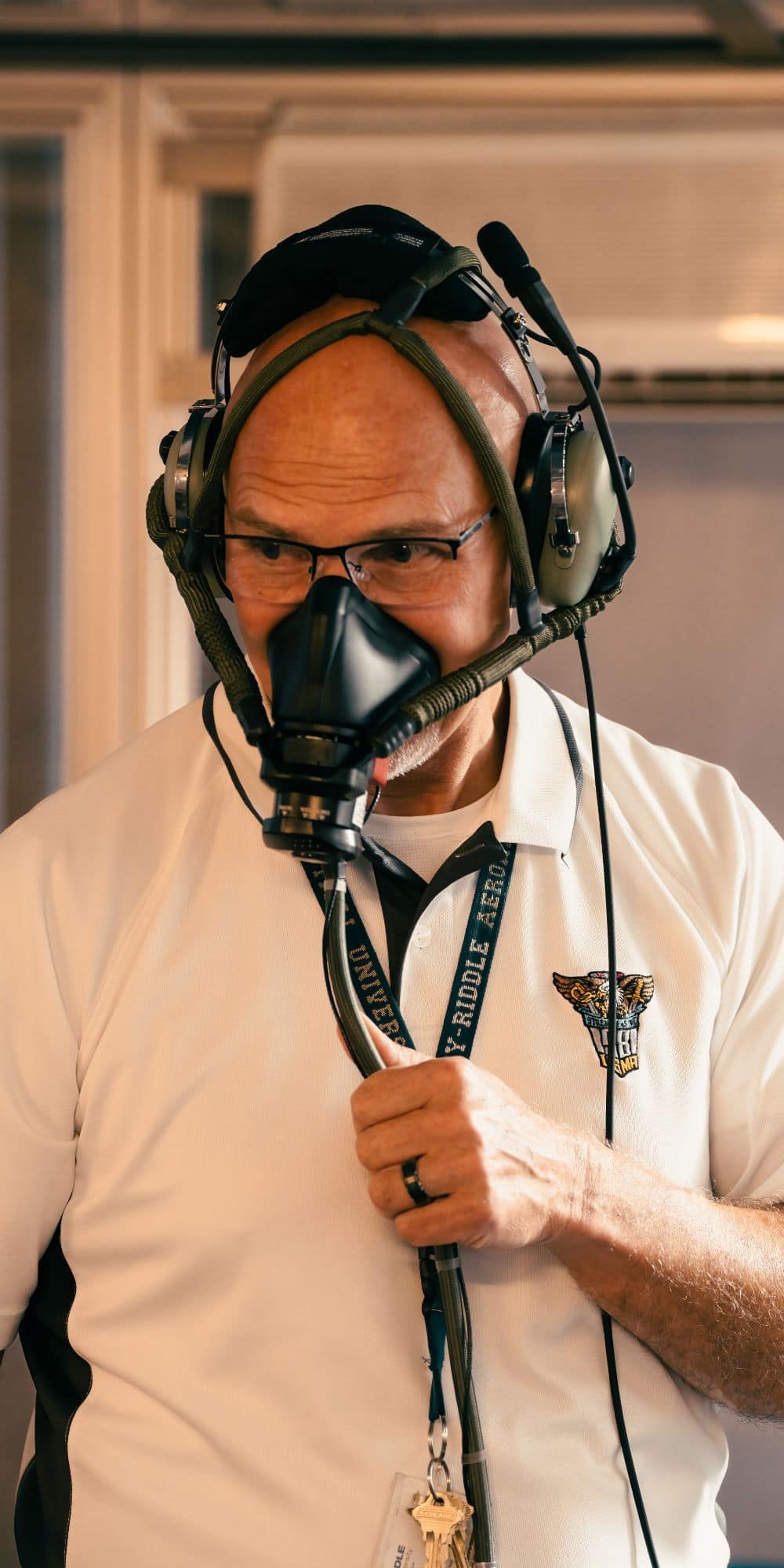

Next Level Labs
High-Altitude Normobaric Chamber

This Lab Takes Your Breath Away
Embry‑Riddle Aeronautical University stands apart as an educational leader in aviation safety thanks to cutting-edge facilities that allow pilots-in-training and student researchers to directly experience and understand some of the chief dangers facing those on the flight deck.
That’s the function of HAL, the High-Altitude Lab, which focuses on the insidious impact of hypoxia and is able to simulate the condition so students recognize symptoms in themselves and signs in fellow crew members.
What is hypoxia and what does it do to the body? Caused by lowered blood oxygen levels, the condition can be hard to recognize and causes symptoms that include euphoria, confusion, anxiety, difficulty breathing and rapid heart rate.
If left unchecked, it can result in unconsciousness and death.
“We have a lot of important labs in the College of Aviation, but none more important than the HAL lab,” said Dr. Alan Stolzer, dean of Embry Riddle’s College of Aviation. “What we do in there is nothing short of amazing, and it something that few other universities are able to offer. The HAL is a fantastic teaching and research environment for our academic community and industry partners.”
Why do pilots need to recognize hypoxia?
The silent and subtle killer has played a key role in untold aviation mishaps, including the much-publicized crash of a Helios Airways Boeing 737 in Greece in 2005 after a pressurization issue incapacitated everyone on board, including the two pilots.
“The primary objective of the lab is for students to experience first-hand the symptoms of hypoxia,” said Scott Wagner, an assistant professor in the College of Aviation and the lab director. “Academically, all pilots are trained about hypoxia, but HAL allows them to feel those symptoms, which are not always easy to recognize.”
HAL is located in the College of Aviation building next door to the Spatial Disorientation Lab, and was launched in 2008 by Professor Glenn Harmon, a former U.S. Air Force flight physiologist who has since retired from teaching at Embry‑Riddle.
The school opted for a normobaric chamber that can simulate the lack of oxygen but not the lower air pressures mimicked by hypobaric chambers.
“[Hypobaric chambers] are expensive to run and can be dangerous with rapid decompression,” Wagner said. “That means medical people are needed because with expanding gases, people could suffer. The leaders at Embry‑Riddle decided on a normobaric chamber, which is what the FAA also uses now in Oklahoma City.”
As summarized by the Chair of the Aeronautical Science Department, Dr. John Robbins, “The training we conduct in the HAL provides students the tools necessary to quickly identify a hypoxic event, which literally saves lives. We are proud of the work our faculty and students do every day to promote a safer tomorrow for our wonderful industry.”
How does the HAL help student and faculty researchers?
 Lab Director Scott Wagner and his student team ensure that hypoxia training in the HAL is safe for students. (Photo: Embry‑Riddle / Bill Fredette-Huffman)
Lab Director Scott Wagner and his student team ensure that hypoxia training in the HAL is safe for students. (Photo: Embry‑Riddle / Bill Fredette-Huffman)HAL has opened the door for exploration and research into hypoxia, which tends to affect people differently. One recent project is being headed by Dr. John French, professor of Human Factors and Behavioral Neurobiology at the College of Arts & Sciences
Dr. French and his student researchers are evaluating how hypoxia may impact the human vestibular system, which is responsible for sensing movement, gravity and maintaining balance.
The system can be easily disrupted by pressure differences and changes in acceleration, causing spatial disorientation and other issues that are often deadly for pilots. Dr. French’s team is trying to determine if lowered oxygen levels may have the same effect.
A recent session simulated the oxygen level above 20,000 feet for six students, who all experienced different symptoms of hypoxia as Wagner carefully watched over them. Outside the chamber, student researchers used cameras and oxygen level monitors to ensure safety and also record how students reacted when given simple tasks to complete.
“Oftentimes, people don't jump to the immediate conclusion they’re getting hypoxic and that happens inside the chamber even when they already know that is what’s going to happen,” Wagner said.
“We teach them that if this was happening on the flight deck, it would be a real emergency and they have five seconds to get their oxygen masks on,” he added. “We really try to bring the point home that whatever this strangeness that they feel, whether it's euphoria, whether it's tingling in extremities, changes in vision or if they feel weird at all, put the mask on and ask questions later.”
What else is the HAL at Embry‑Riddle used for?
HAL has additional benefits for Embry‑Riddle because it also serves as a go-to hypoxia training center for many corporate and other professional pilots.
From the potential lifesaving and safety training to a valuable research platform, the HAL is another example of the high-level facilities that are routinely available to Embry‑Riddle students and allows them to get the kind of practical experience that is not offered anywhere else.
“Beyond the aviation applications, we have students who are applying and getting into medical schools or training to become physician’s assistants,” Wagner said. “I find that to be pretty exciting. We're at that level with our training and that is certainly a benefit for our students.”
Research experience in hypoxia, particularly for those interested in a career in aerospace life sciences, is another unique opportunity for our students.

